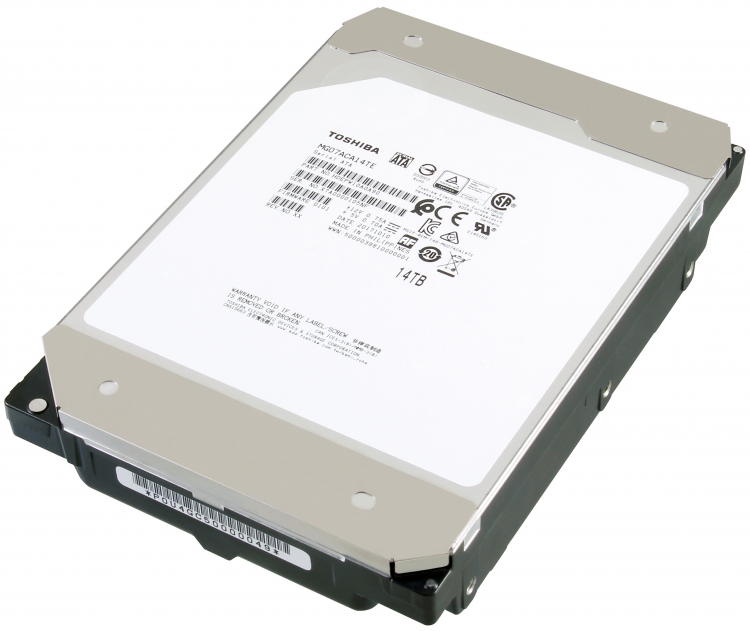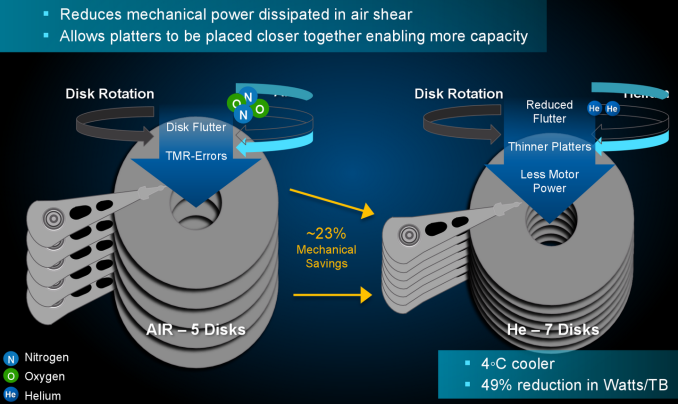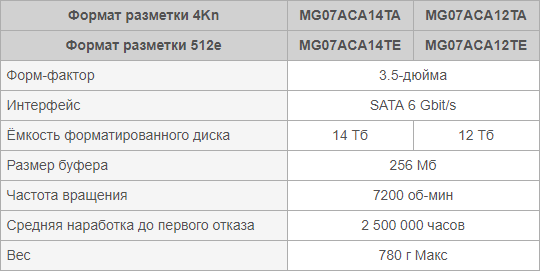
Toshiba
announced this week the imminent entry into the market of a new hard drive. We are talking about the first in this area hard drive with nine plates, the volume of which is 14 TB. The internal space of the disk is filled with helium. In order to achieve a high recording density, the engineers of the company decided to use perpendicular magnetic recording (PMR). All new HDDs are focused on cloud data center operators who need high-capacity storage to avoid the need to expand the DC area. The company will sell discs through distributors.
Toshiba has previously announced that the development of its "helium" hard drives has been going on for several years. As far as can be understood, everything went more or less smoothly, and the company's engineers managed to achieve the desired. The new hard drive has become one of the most complex in terms of technology. The fact is that here nine plates are used at once, up to 18 heads and the maximum density of PMR recording.
In a 14-terabyte disk, the capacity of each of the nine plates is 1.5 TB. In order for all nine plates to be able to fit into the hard disk case, the company has made them thin. Plate thickness is only 0.635 mm. The distance between the plates is 1.58 mm. The newest HDD uses a new type of TDK head, which allows you to work with thin plates. There is one more innovation: the HDD casing is completely sealed, it was made using laser welding. Inside, apart from the plates, there are Nidec engines, which are intended for information carriers filled with helium. Internal connectors are also sealed.
Despite its complexity, the discs are designed to last as long as possible. To this end, engineers have implemented a number of solutions to improve the reliability and durability of disks. For example, miniature electric motors are attached simultaneously to the lower and upper plane of the drive. In addition, the HDD is equipped with vibration sensors, plus the environment. In order for the drives to work for the longest possible time, they were tried to be isolated from vibration, since it reduces the operating time of the hard drives.

Toshiba Corp. claims that there will be no problems with disks over a long service life. So, the company guarantees the absence of any problems with an average annual workload of 550 TB. 2.5 million hours of time between failures were declared. Disks come with a five year warranty.
It is worth noting that new hard drives work with a special cache buffer (persistent write cache, PWC) based on NAND flash memory with power loss protection (PLP). This also increases the service life of the disks. Especially important is the new type of buffer for HDD with 4 KB sectors, emulating 512-byte sectors, which allows for compatibility with obsolete software. Here the advantage of the buffer is that it protects the data even if there is a loss of power during the read-modify-write (RMW) operation. Toshiba has done everything to meet the needs of customers with the most advanced hardware and software systems that require new data storage volumes.
Toshiba will
sell not only 14 TB, but 12 TB versions of its disks. The model has a smaller capacity one plate less. Both models provide a spindle speed of 7200 rev / min, and. The cache buffer of both models is 256 MB, the interface is Serial ATA 6 Gb / s. The older model allows you to transfer data at a speed of 260 MB per second, the youngest is only slightly inferior to the leader.

Helium is not used in hard drives. Its density is seven times lower than normal air. And this allows you to reduce the friction force that acts on the magnetic plates inside the hard drives. It also opens up the possibility to reduce the force of gas flows, acting on the accuracy of the positioning of the heads and plates. As a result, helium-filled hard drives consume much less energy than conventional HDDs. In quantitative terms, this is 7.6 watts in read / write mode. In standby mode, the indicator is 4.6 watts. According to this parameter, the hard disk is one of the leaders - few models have the same energy efficiency.
According to the company, data centers can easily increase the available storage capacity of information, replacing, for example, their 10-terabyte drives with 14-terabyte. In this case, the power consumption of the rack will slightly decrease, or it will remain unchanged. But the capacity for this will increase immediately by 40%.